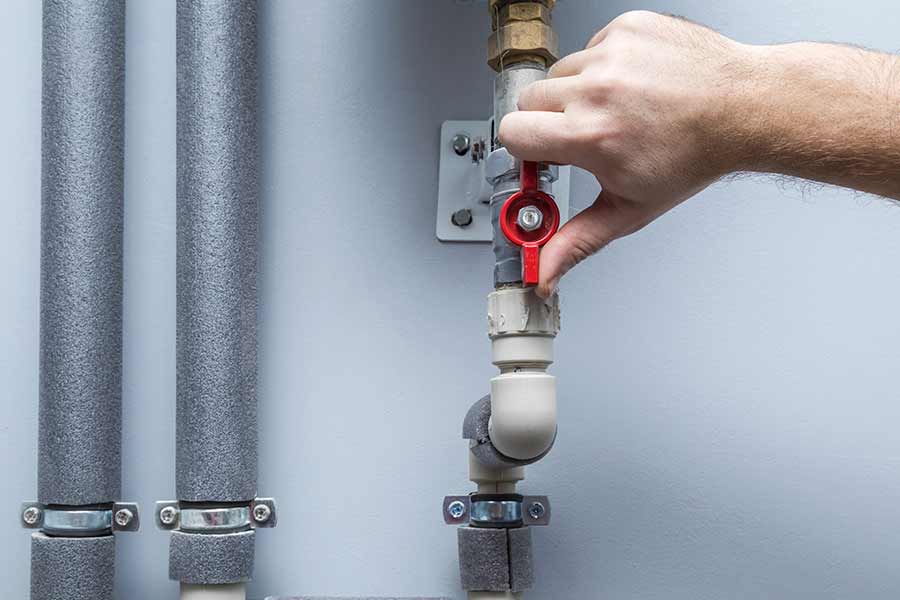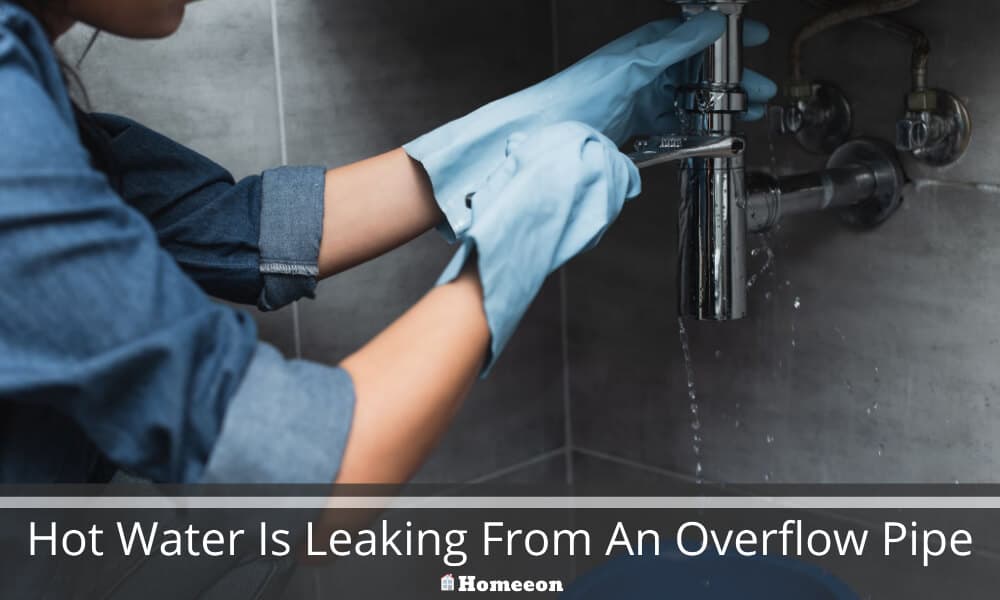Last Updated on August 10, 2023 By Emma W. Thomas
When hot water leaks from an overflow pipe, it may indicate a pressure relief valve issue in your water heater. First, turn off the heater and water supply. Contact a professional plumber to inspect and potentially replace the faulty valve. Ignoring this can lead to water heater damage.
What to do when you notice a water leak from an overflow pipe

1. Identify The Cistern Or Reservoir That Is Overflowing
If the leaking pipe is on the first or ground floor, then it is likely that it’s your bathroom overflow pipe leaking. It means that the overflow is from your toilet’s cistern. But if the leak is at loft level and bulges out from the roof’s eaves, it means that it is coming from your central heating or cold-water feed and expansion tank.
If you are still not sure, check these places for the water level, and if you find out that it is near the overflow or above the limescale ring, which shows its usual level, you know where the problem is. It may sometimes be difficult to notice a leakage when only a small amount of water is dripping. In this case, check early in the morning when the water level is high in the cistern.
2. Observe The Float Valve
If the water is pouring into the tank continuously, the float valve could be sticking down. Raise it up to free it and check if something is stopping it from moving freely. If nothing is preventing it from moving, check if the plastic ball is punctured and whether it is filled with water. If this is the issue, you will have to replace the ball. However, if none of the above has a problem, you will have to replace the washer as it could be faulty.
3. Shut The Water Feed And Pour The Water
If you confirm that the issue is with your float valve, replace it or the washer. You will need to stop the water flow into the tank first then drain it completely.
- For you to turn the water feed off on the toilet cistern, use a valve located on the water pipe leading into the cistern (isolation valve)
- Use a screwdriver (flat-head) to turn the screw 90 degrees clockwise. Flush the toilet to empty all the water
- Put off the mains water at the stopcock to prevent water from getting into the tank
- Turn on your bathroom taps to drain the water up to the level you want to work on
What is an overflow pipe?
Overflow pipes serve a crucial role in various systems, preventing damage and ensuring safety. Whether you have encountered it in your home’s plumbing or heard about it in relation to other systems, understanding what an overflow pipe is and how it works is essential. Let’s dive into the details and explore everything you need to know about overflow pipes.
1. Definition and Purpose
An overflow pipe is a pipe designed to control the flow of liquid or gas by providing an outlet for excess fluids or gases when normal channels can no longer accommodate them. It acts as a fail-safe mechanism, preventing potential damage or accidents that may occur due to excessive pressure or overflowing.
2. Residential Applications
One of the most common places where we encounter overflow pipes is in residential plumbing systems. In a typical scenario, the overflow pipe is connected to a storage tank, such as a water heater or a toilet cistern. When the tank reaches its maximum capacity, the overflow pipe diverts the excess water to a drain, preventing flooding and potential damage.
3. Further Exploring Plumbing Systems
In addition to the residential plumbing systems mentioned above, overflow pipes are also an integral part of various other plumbing installations. They are commonly found in bathtubs, sinks, and even outdoor drainage systems. The purpose remains the same – to safeguard against water damage caused by excessive overflow.
4. Industrial and Commercial Applications
Overflow pipes go beyond residential plumbing; they are widely used in industrial and commercial settings as well. Industries that deal with hazardous liquids, such as chemicals or fuels, employ overflow pipes in their storage tanks to ensure no spills or leaks occur, protecting the environment and those working nearby.
5. How Does an Overflow Pipe Work?
Overflow pipes are generally designed to be located at a height above the maximum desired liquid level. The excess fluid enters the pipe through an inlet and is safely directed away from the primary system. The construction of the overflow pipe ensures a smooth flow and helps maintain pressure balance within the system.
What To Do When Your Toilet Overflow Pipe Leaks
Your toilet’s overflow pipe runs from the cistern to the outside of your house. The tube is usually made of copper, plastic, or lead, and it usually goes out via the wall directly behind the toilet. If the leakage is outside your toilet’s overflow pipe, it means the cistern is not closing. There are various solutions to this problem;
1. Check Whether The Float Valve Is Stuck.
The float valve could either be stuck or entangled in the chain that helps open the flapper valve when the toilet is flushed. If the valve is stuck, raise it up so it moves freely.
2. Regulate The Position Of The Float
Your ball’s height that helps to shut off the water feed could be too high. If the arm is made of metal, bend it down to lower the size of the ball. However, if it is plastic, turn the adjustment screw at the top of the arm to move the float’s position.
3. Test The Pressure Of The Water Feed
If the water pressure coming into the tank is too high, it could cause the overflow pipe to leak. Turn down the flow of water using the isolation valve.
4. Change The Washer In The Float Valve
If the water feed does not shut up even when the cistern is full, you can try to replace the washer. Start by switching off the water supply, then drain the cistern by flushing the toilet. Open the float valve and remove the old washer and replace it with a new one. Ensure that you buy the perfect size of the washer before putting it in the float valve and putting it back in place.
What Causes An Overflow From Expansion Tank And Central Heating Feed Leaks
The expansion tank and central heating feed overflow tube lead from the small water reservoir in your attic to the outside of your house. The pipe is made either of copper, plastic, or lead, and it runs out through the soffits and eaves. The tank supplies your hot water system and lets water expand when the system is heated.
If this overflow pipe leaks, it could be as a result of;
1. Water Feed Into The Tank Not Closing
When you look at the tank’s inside and notice some water dripping from the water feed, test that the ball valve is not stuck. Adjust the position of the float valve if need be and test if it needs to be replaced.
2. The Water Cylinder Could Be Faulty
If the float valve isn’t faulty and the cold water feed closes right, then the problem is with the hot water cylinder.
How To Stop Your Water Heater From Overflowing

There is a ball valve in the feed and expansion tank that controls the tank’s water flow. If hot water drips out of the overflow pipe, switch off the system and wait for a short while for the water to cool down. Adjust the float valve to let in little water into the tank.
Conclusion
An overflow pipe runs from a cistern or water storage tank inside the home to the outside. The components with overflow pipes in your home include a toilet cistern, copper cylinder, sinks, basins, baths, central heating feed, and an expansion tank.
If there is a leakage from the overflow pipe, check what causes the problem, then fix them as per the suggestions above.
References:
https://www.corroprotec.com/faq/water-heater-leaking-from-overflow-pipe/
https://www.homeserve.com/uk/living/how-to/overflow-pipe-leaking/
Emma is a graduate of Domestic Science or Family and Consumer Sciences (Home Economics) from the University of Wisconsin. She has 7 years of experience Working with the strategic section of BestBuy and now writing full-time for Homeeon.
From Managing the Home, Interiors, Cleaning, and Exteriors to Gardening and everything about Making A Home Liveable – is her passion and this Homeeon is the result of this.
Emma loves decorating her home with the best stuff found online. She cares about quality over anything and writes reviews about them here in Homeeon. Get in touch with her over Pinterest.
Keep reading her blogs.

